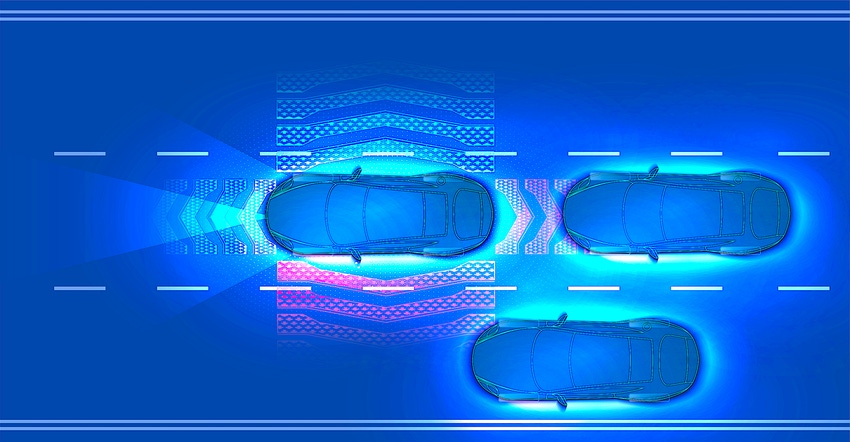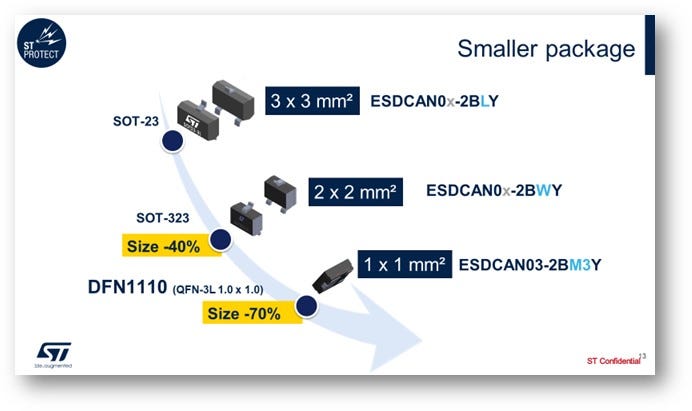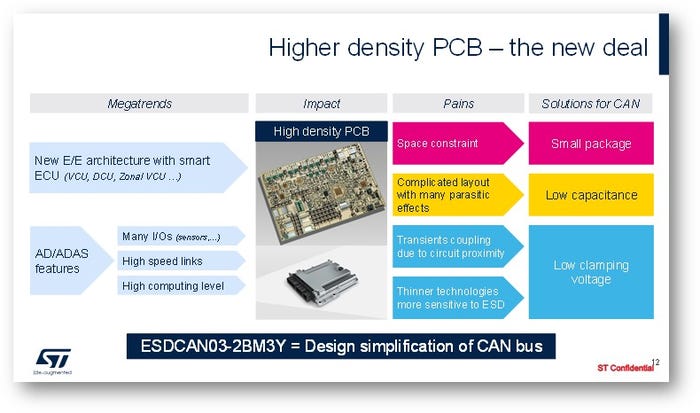STMicroelectronics has a new low-capacitance automotive transient voltage suppressor that delivers protection for high-speed interfaces.

With the release of the new ESDCAN03-2BM3Y dual automotive-qualified low-capacitance transient voltage suppressor (TVS), STMicroelectronics offers a compact solution to protection for CAN, CAN-FD, FlexRay, and USB interfaces in cars.
This is particularly relevant to automotive Electronic Control Units (ECU) and Advanced Driver Assistance Systems (ADAS). The 1.1mm x 1.0mm ESDCAN03-2BM3Y TVS saves 75 percent or more of the PCB space needed by conventional TVS in SOT23-3L and SOT323-3L packages.
In addition to its small size, the ESDCAN03-2BM3Y boasts a heat-tolerant maximum junction temperature rating of 175°C, allowing its use throughout the vehicle rather than only in more temperate areas.
These improvements suggest the ability to develop better automotive ECUs and ADAS systems, so we put some questions to STMicroelectronics senior product engineer Jean Garcia.
Design News: What is different about the ESDCAN03-2BM3Y compared to its predecessor?
Jean Garcia: The ESDCAN03-2BM3Y is the first member of our ESDCAN series to be housed in such a small package DFN1110:

Compared to the previous generation, we have improved the clamping voltages performances by using a new technology derived from the ones addressing smartphones demanding market segment.

This is important to reduce the clamping voltage of CAN transceiver protection because the latest thinnest technologies used for high-speed transceivers are more vulnerable to ESD.
High-density boards, due to increased electronics content (ADAS, autonomous driving, electrification, and new E/E architecture), make ESD coupling easier than on standard boards.
It is highly critical on such boards to prevent the ESD surge to propagate into the circuitries by clamping the spikes as close as possible to the entry point and keeping the residual clamping voltage as low as possible.
DN: What are the advantages of this smaller TVS for building automotive ECUs and ADAS systems?
Jean Garcia: ADAS megatrends create a tremendous need for sensing and computing. It means, at the sensor fusion point, on the same board, you will have tens of sensor inputs combined to high & fast computing processors and chips. Some ECUs like Domain Controller Units or Vehicle Controller Unit embed dozens of CAN ports on A5-size boards.
DN: How important is the ability to also protect FlexRay and USB buses?
Jean Garcia: The low capacitance of our device provides high versatility. With the same part number, you can protect CAN, FlexRay, and even USB or Ethernet (on the transceiver side). It simplifies the BOM.
DN: What flexibility does the high-temperature rating give the OEM?
Jean Garcia: Let me quote an STMicrolectronics blog article: “The ESDCAN03-2BM3Y also stands out in reliability measurements as ST certified a junction temperature of 175 ºC. The number itself may sound boastful since nothing in the car will reach this number. However, the reason we continue to offer such a rating is to ensure that we meet every single mission profile currently enforced. Engineers won’t have to ask ST to run more reliability tests, and they won’t have surprises. We already ran benchmarks at temperatures that exceed what the industry is looking for. As a result, companies will rapidly know if the component will meet their requirements.”
We have performed all our reliability tests at 175°C providing a much better acceleration factor than doing them at 150°C. So we emulate with 1000h of HTRB performed at 175°C for example a much longer active time than at 150°C.
It means that when a Tier1 asks us to confirm if we pass their own and specific mission profiles for their specific project or application, 99.99 percent of the time we say “yes” without having to perform additional reliability testing. We provide immediate answers and can move to the next step. An additional 1000h would mean another six weeks delay.
And for temperature-critical applications like exhaust gas recirculation, oxides of nitrogen catalysts, or the gearbox that may sometimes exceed the 150°C standard, our ESDCAN series is preferred.
DN: How does the low battery drain compare to previous devices?
Jean Garcia: This is the benchmark of our series. Most of ESDCAN members are rated 100 nA max leakage current. ESDCAN03-2BM3Y (together with ESDCAN04-2BxY) is rated 50 nA only. It is critical for EVs to minimize the leakage current of each and every component.
The automotive industry has to solve a complicated equation. The electronics content of EV cars (due to electrification but also to high level of ADAS features) increases the number of components and thus the overall battery leakage. It is critical for a user back from holidays to be able to crank her or his EV car left for three weeks in an airport parking lot and to come back to home. This requires an extremely low leakage current of every single component.
DN: Finally, how can automotive OEMs build a better ADAS system thanks to this device?
Jean Garcia: It simplifies designers' and PCB engineers' lives and it makes the design safe and robust, as illustrated by this chart.

About the Author(s)
You May Also Like





